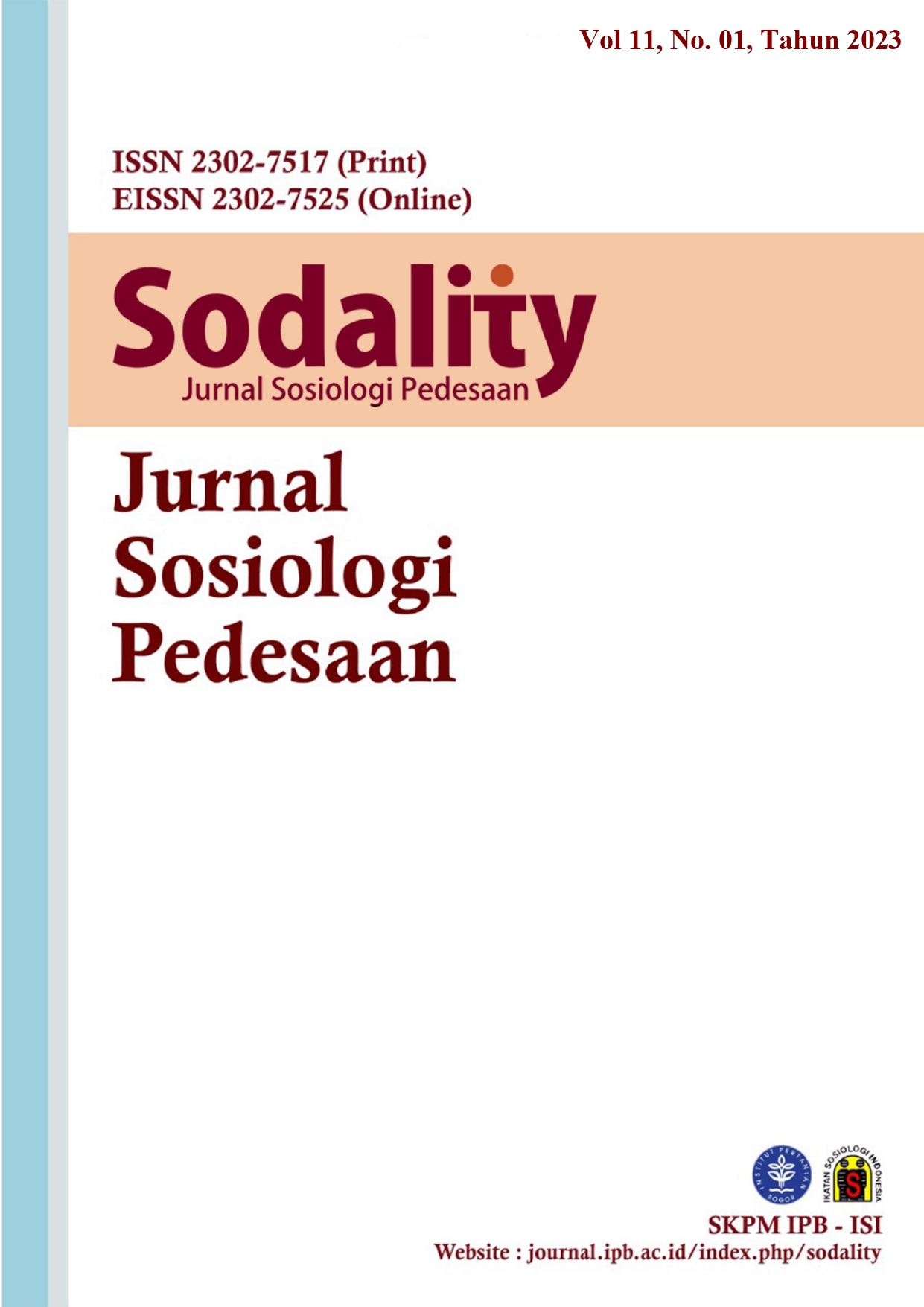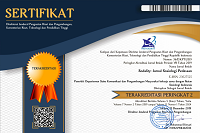Entrepreneurship Ethical Embeddedness of Weaver Women in the Social Structures of Bugis Ethnic Group in South Sulawesi
Abstract
Loom development and the entry of the market economy system into the socio-economic system of weavers create three weaver groups with different entrepreneurial ethics. This research aims to describe the differences in entrepreneurial ethics of weaver women in South Sulawesi so that they could survive from market economy system penetration. The research uses a qualitative approach. The data collection method is conducted through in-depth interviews, observation, and focus group discussion. Data analysis consists of three steps, namely, data reduction, data presentation, and conclusion drawing. The research results indicate that there are differences in entrepreneurial ethics between the three weaver groups. Gedogan (primitive loom) weavers have oversocialized entrepreneurial ethics, improved handloom (Alat Tenun Bukan Mesin) weavers have an entrepreneurial ethics between oversocialized and undersocialized, whilst weaving business women have an entrepreneurial ethics that is more towards undersocialized action. The strong embeddedness of entrepreneurial ethics in the oversocialized pole induces gedogan weavers as the strongest group in addressing price fluctuations and external interventions in textile production. A balanced embeddedness of entrepreneurial ethic between oversocialized and under socialized actions among the ATBM weavers makes them the most prone to failure in business due to limited capital, production, and network that makes them unable to compete with local weaving entrepreneurs at national and global levels. The embeddedness of weaving entrepreneurs' actions in the under socialized pole makes does not make to play a further role in economic activities, but their economic success is compensated by religiousness and social piety.
References
Acs, Z. J., Song, A. K., Szerb, L., Audretsch, D. B., & Komlosi, E. (2021). The evolution of the global digital platform economy: 1971–2021. Small Business Economics, 57(4), 1629–1659. DOI: 10.1007/s11187-021-00561-x.
Agrawal, R. (2018). Constraints and Challenges Faced by Women Entrepreneurs in Emerging Market Economy and the Way Forward. Journal of Women’s Entrepreneurship and Education, 3(4), 1–19. https://doi.org/10.28934/jwee18.34.pp1-19
Ahmed, N., Allison, E. H., & Muir, J. F. (2010). Rice fields to prawn farms: a blue revolution in southwest Bangladesh? Aquaculture International, 18(4), 555–574. DOI: 10.1007/s10499-009-9276-0
Anderson, S., & Eswaran, M. (2009). What determines female autonomy? Evidence from Bangladesh. Journal of Development Economics, 90(2), 179–191. DOI: 10.1016/j.jdeveco.2008.10.004.
Arsita, M., Zuber, A., & Demartoto, A. (2020). The Social Embeddedness of MSMEs Goyor Woven Sarong in Sambirembe Village, Kalijambe, Sragen. Society, 8(2), 359–371. DOI: 10.33019/society.v8i2.198.
Baba, G. K. (2013). The challenges of entrepreneurship development in Nigeria and way forward. Journal of Business and Organizational Development, 5(1), 54–64.
Bamiatzi, V. C., & Kirchmaier, T. (2014). Strategies for superior performance under adverse conditions: A focus on small and medium-sized high-growth firms. International Small Business Journal, 32(3), 259–284. DOI: 10.2139/ssrn.1332087.
Benz, M. (2009). Entrepreneurship as a non-profit-seeking activity. International Entrepreneurship and Management Journal, 5(1), 23-44. DOI: 10.1007/s11365-006-0031-y
Bergh, P., Thorgren, S., & Wincent, J. (2011). Entrepreneurs learning together: The importance of building trust for learning and exploiting business opportunities. International Entrepreneurship and Management Journal, 7(1), 17–37. DOI: 10.1007/s11365-009-0120-9.
Bhagavatula, S., Elfring, T., Van Tilburg, A., & Van De Bunt, G. G. (2010). How social and human capital influence opportunity recognition and resource mobilization in India’s handloom industry. Journal of Business Venturing, 25(3), 245–260. DO:10.1016/j.jbusvent.2008.10.006.
Boufeldja, G. (n.d.). Women as Entrepreneurship in Algeria. 34–44. https://doi.org/10.28934/jwee18.34.pp34-44
Brush, C. G., & Cooper, S. Y. (2012). Female entrepreneurship and economic development: An international perspective. Entrepreneurship & Regional Development, 24(1–2), 1–6. DOI: 10.1080/08985626.2012.637340.
Burman, S. (2004). Revisiting the agent of social control role: Implications for substance abuse treatment. Journal of Social Work Practice, 18(2), 197–209. DOI: 10.1080/0265053042000231016.
Carter, D. A., Simkins, B. J., & Simpson, W. G. (2003). Corporate governance, board diversity, and firm value. Financial Review, 38(1), 33–53. DOI: 10.1111/1540-6288.00034.
Casson, M., & Giusta, M. Della. (2007). Entrepreneurship and social capital: Analysing the impact of social networks on entrepreneurial activity from a rational action perspective. International Small Business Journal, 25(3), 220–244. DOI: 10.1177/0266242607076524.
Cheung, F. M., & Halpern, D. F. (2010). Women at the top: Powerful leaders define success as work+ family in a culture of gender. American Psychologist, 65(3), 182. DOI: 10.1037/a0017309.
Cohen, J. H. (1998). Craft production and the challenge of the global market: An artisans’ cooperative in Oaxaca, Mexico. Human Organization, 74–82. DOI: 10.17730/humo.57.1.g3m5038h835r77lm.
Connell, J. (2010). Pacific islands in the global economy: Paradoxes of migration and culture. Singapore Journal of Tropical Geography, 31(1), 115–129. DOI: 10.1111/j.1467-9493.2010.00387.x.
Curran, J., Jarvis, R., Kitching, J., & Lightfoot, G. (1997). The pricing decision in small firms: complexities and the deprioritising of economic determinants. International Small Business Journal, 15(2), 17–32. DOI. 10.1177/02662426971520.
Dacin, P. A., Dacin, M. T., & Matear, M. (2010). Social entrepreneurship: Why we don’t need a new theory and how we move forward from here. Academy of Management Perspectives, 24(3), 37–57. DOI: 10.5465/amp.24.3.37.
De Vita, L., Mari, M., & Poggesi, S. (2014). Women entrepreneurs in and from developing countries: Evidences from the literature. European Management Journal, 32(3), 451–460. DOI: 10.1016/j.emj.2013.07.009.
Denzin, N. K., & Lincoln, Y. S. (2011). The Sage handbook of qualitative research. sage.
Eslam, M., Sanyal, A. J., George, J., Sanyal, A., Neuschwander-Tetri, B., Tiribelli, C., … Yki-Järvinen, H. (2020). MAFLD: a consensus-driven proposed nomenclature for metabolic associated fatty liver disease. Gastroenterology, 158(7), 1999–2014.
Field, E., Jayachandran, S., & Pande, R. (2010). Do traditional institutions constrain female entrepreneurship? A field experiment on business training in India. American Economic Review, 100(2), 125–129. DOI: 10.1257/aer.100.2.125.
Geertz, C. (1963). Peddlers and princes: Social development and economic change in two Indonesian towns (Vol. 318). University of Chicago Press.
Granovetter, M. (1985). Economic action and social structure: The problem of embeddedness. American Journal of Sociology, 91(3), 481–510. DOI: 10.1086/228311.
Granovetter, M. (1992a). Economic Action and Social Structure: The Problem of Embeddedness dalam M. Granovetter dan R. Swedberg (Eds). The Sociology of Economic Life. Westview Press Inc. Boulder-San Fransisco-Oxford.
Granovetter, M. (1992b). Economic institutions as social constructions: a framework for analysis. Acta Sociologica, 35(1), 3–11. DOI: 10.1177/000169939203500101.
Grine, F., Fares, D., & Meguellati, A. (2015). Islamic spirituality and entrepreneurship: A case study of women entrepreneurs in Malaysia. The Journal of Happiness & Well-Being, 3(1), 41–56.
Haggblade, S., Hazell, P., & Reardon, T. (2010). The rural non-farm economy: Prospects for growth and poverty reduction. World Development, 38(10), 1429–1441. DOI: 10.1016/j.worlddev.2009.06.008.
Harvie, C. (2003). The contribution of micro-enterprises to economic recovery and poverty alleviation in East Asia.
Hitt, M. A., Ireland, R. D., Sirmon, D. G., & Trahms, C. A. (2011). Strategic entrepreneurship: creating value for individuals, organizations, and society. Academy of Management Perspectives, 25(2), 57–75. DOI: 10.2139/SSRN.1994491.
Huberman, M., & Miles, M. B. (2002). The qualitative researcher’s companion. Sage.
Inanna, I., Rahmatullah, R., Haeruddin, M., & Marhawati, M. (2020). Silk weaving as a cultural heritage in the informal entrepreneurship education perspective. Journal of Entrepreneurship Education, 23(1), 1–11.
Isaga, N. (2019). Start-up motives and challenges facing female entrepreneurs in Tanzania. International Journal of Gender and Entrepreneurship, 11(2), 102–119. DOI: 10.1108/IJGE-02-2018-0010.
Ishwarlall Naicker, N. (2006). Factors contributing to women being successful in the SMME sector. University of Johannesburg.
Jamilah, J., Dharmawan, A. H., Panjaitan, N. K., & Damanhuri, D. S. (2016). Embeddedness of Moral and Culture Institutions with Embroidery Entrepreunership in Tasikmalaya. Sodality: Jurnal Sosiologi Pedesaan, 4(3). DOI: 10.22500/sodality.v4i3.14432.
Kabeer, N. (1997). Women, wages and intra‐household power relations in urban Bangladesh. Development and Change, 28(2), 261–302. DOI: 10.1111/1467-7660.00043.
Kay, A. C., Shepherd, S., Blatz, C. W., Chua, S. N., & Galinsky, A. D. (2010). For God (or) country: the hydraulic relation between government instability and belief in religious sources of control. Journal of Personality and Social Psychology, 99(5), 725. DOI: 10.1037/a0021140.
Langowitz, N., & Minniti, M. (2007). The entrepreneurial propensity of women. Entrepreneurship Theory and Practice, 31(3), 341–364. DOI: 10.1111/j.1540-6520.2007.00177.x.
Lenggono, P. S. (2011). Ponggawa dan Patronase Pertambakan di Delta Mahakam: Teori Pembentukan Ekonomi Lokal. Disertasi SPD-IPB.
Mahajar, A. J. Bin, & Yunus, J. B. M. (2012). Factors that encourage women involvement in SMEs in Pahang, Malaysia. The Journal of Human Resource and Adult Learning, 8(2), 33.
Meek, W. R., Pacheco, D. F., & York, J. G. (2010). The impact of social norms on entrepreneurial action: Evidence from the environmental entrepreneurship context. Journal of Business Venturing, 25(5), 493–509. DOI: 10.1016/j.jbusvent.2009.09.007.
Minniti, M. (2005). Entrepreneurship and network externalities. Journal of Economic Behavior & Organization, 57(1), 1–27. DOI: 10.1016/j.jebo.2004.10.002.
Moffett, H. (2006). ‘These women, they force us to rape them’: Rape as narrative of social control in post-apartheid South Africa. Journal of Southern African Studies, 32(1), 129–144. DOI: 10.1080/03057070500493845.
Mooney, P. H. (1986). Farming, rationality, and craftship: Beyond X-efficiency. Agriculture and Human Values, 3(4), 54–58. DOI: 10.1007/BF01535485.
Muñoz Abeledo, L. (2012). Women in the rural and industrial labor force in nineteenth-century Spain. Feminist Economics, 18(4), 121–144. DOI: 10.1080/13545701.2012.738302.
Oosterbeek, H., Van Praag, M., & Ijsselstein, A. (2010). The impact of entrepreneurship education on entrepreneurship skills and motivation. European Economic Review, 54(3), 442–454. DOI: 10.1016/J.euroecorev.2009.08.002.
Orser, B., & Elliott, C. (2015). Feminine Capital: Unlocking the power of women entrepreneurs. Stanford University Press.
Pelras, C., & Pelras. (1996). The Bugis. Blackwell Publishers Oxford.
Portes, A. (2010). Economic sociology. In Economic Sociology. Princeton University Press.
Poschke, M. (2013). Who becomes an entrepreneur? Labor market prospects and occupational choice. Journal of Economic Dynamics and Control, 37(3), 693–710. DOI: 10.1016/j.jedc.2012.11.003.
Roomi, M. A. (2009). Impact of social capital development and use in the growth process of women-owned firms. Journal of Enterprising Culture, 17(04), 473–495. DOI: 10.1142/S0218495809000436.
Rose‐Ackerman, S. (2001). Trust and honesty in post‐socialist societies. Kyklos, 54(2‐3), 415–443. DOI: 10.1111/j.0023-5962.2001.00161.x.
Salameh, M. S. (2016). Palestinian women entrepreneurs: an exploratory study of intentions relatedness to business sustainability.
Seelos, C., Mair, J., Battilana, J., & Tina Dacin, M. (2011). The embeddedness of social entrepreneurship: Understanding variation across local communities. DOI: 10.1108/S0733-558X(2011)0000033013.
Shapiro, S. P. (1987). The social control of impersonal trust. American Journal of Sociology, 93(3), 623–658. DOI: 10.1086/228791.
Simmel, G., Accarino, B., & Ferrarotti, F. (1982). La differenziazione sociale. Laterza Roma-Bari.
Stadler, N. (2002). Is profane work an obstacle to salvation? The case of Ultra Orthodox (Haredi) Jews in contemporary Israel. Sociology of Religion, 63(4), 455–474. DOI: 10.2307/3712302.
Syukur, M. (2014). Transformasi Penenun Bugis Wajo Menuju Era Modernitas. Paramita: Historical Studies Journal, 24(1). DOI: 10.15294/paramita.v24i1.2864.
Udofot, P., & John, N. E. (2017). Ethical Sensitivity and Success of Female Entrepreneurs in Akwa Ibom State of Nigeria. Saudi Journal of Business and Management Studies, 2(3), 179–184. DOI: 10.21276/sjbms.2017.2.3.9.
Van Staveren, I., & Knorringa, P. (2007). Unpacking social capital in economic development: How social relations matter. Review of Social Economy, 65(1), 107–135. DOI: 10.1080/00346760601132147.
Venkataraman, S. (2004). Regional transformation through technological entrepreneurship. Journal of Business Venturing, 19(1), 153–167. DOI: 10.1016/j.jbusvent.2003.04.001.
Warren‐Smith, I., & Jackson, C. (2004). Women creating wealth through rural enterprise. International Journal of Entrepreneurial Behavior & Research. 10 (6). DOI: 10.1108/13552550410564707.
Weber, M. (1978). Economy and society: An outline of interpretive sociology (Vol. 1). Univ of California Press.
Welter, F. (2012). All you need is trust? A critical review of the trust and entrepreneurship literature. International Small Business Journal, 30(3), 193–212. DOI: 10.1177/0266242612439588.
West, C. C. (1999). Power, Truth, and Community in Modern Culture. A&C Black.
Wickramasekara, P. (2016). South Asian Gulf migration to the Gulf: a safety valve or a development strategy? Migration and Development, 5(1), 99–129. DOI: 10.1080/21632324.2015.1039770.
Zafirovski, M. (1999). Profit-making as social action: An alternative social-economic perspective. Review of Social Economy, 57(1), 47–83. DOI: 10.1080/00346769900000026.
Authors who publish with this journal agree to the following terms:
- Authors retain copyright and grant the journal right of first publication with the work simultaneously licensed under a

This work is licensed under a Creative Commons Attribution 4.0 International License. that allows others to share the work with an acknowledgement of the work's authorship and initial publication in this journal. - Authors are able to enter into separate, additional contractual arrangements for the non-exclusive distribution of the journal's published version of the work (e.g., post it to an institutional repository or publish it in a book), with an acknowledgement of its initial publication in this journal.
- Authors are permitted and encouraged to post their work online (e.g., in institutional repositories or on their website) prior to and during the submission process, as it can lead to productive exchanges, as well as earlier and greater citation of published work (See The Effect of Open Access).





.png)









